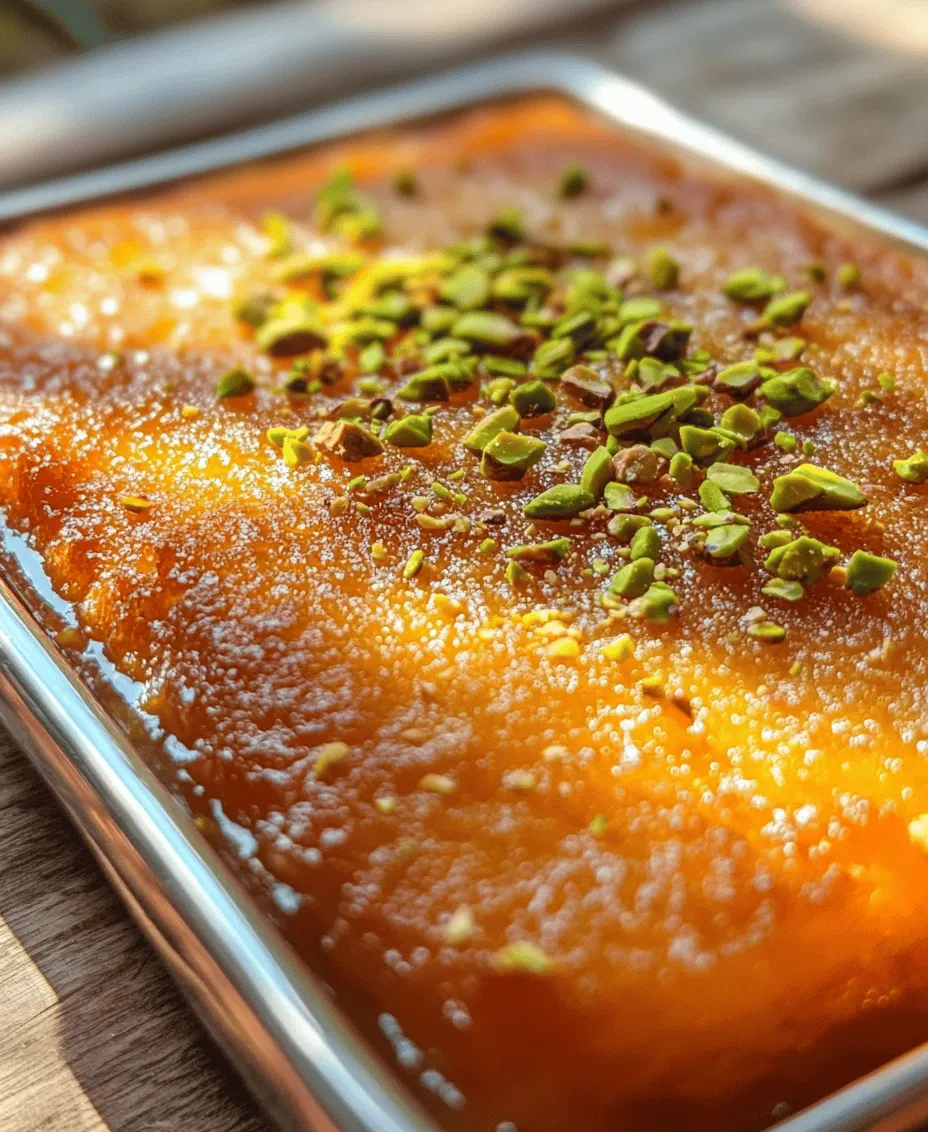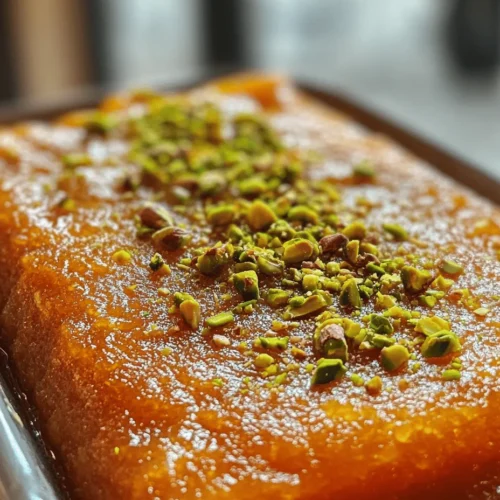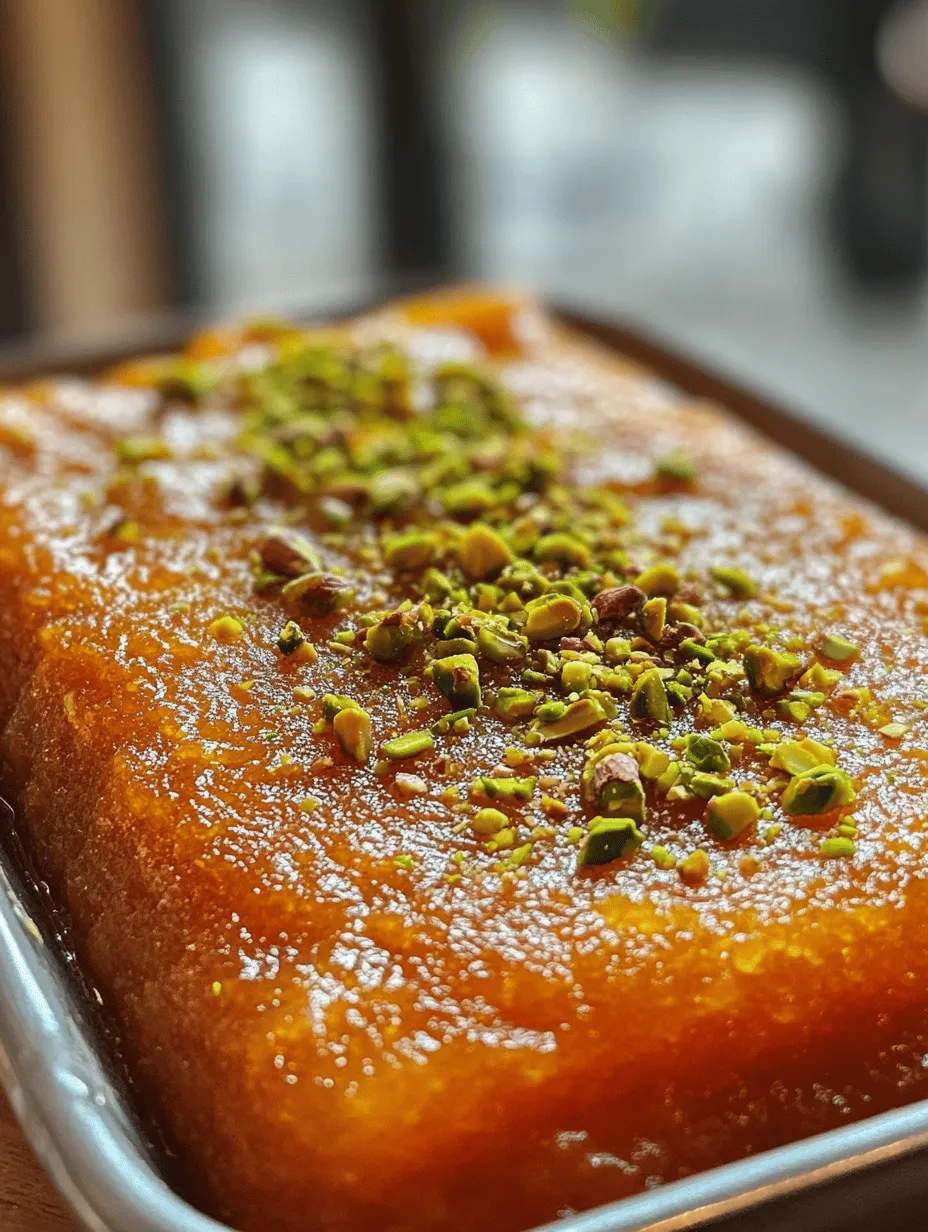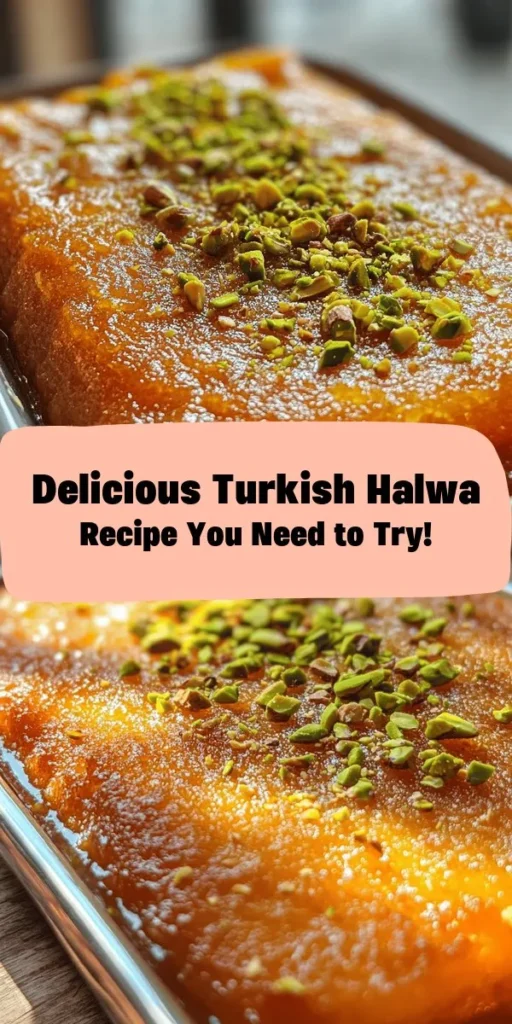Introduction
Turkish Halwa, known locally as “Sad el Hanak,” is a beloved sweet treat that has captivated dessert lovers around the globe. This dish is more than just a dessert; it embodies the rich tapestry of Turkish culture and tradition. Halwa, in its many forms, is enjoyed in various regions, often served during festive occasions and celebrations. This unique dessert is characterized by its delightful texture and sweet flavor, making it an irresistible addition to any gathering.
In this article, we will dive into the world of Turkish Halwa (Sad el Hanak) Delight, exploring its cultural significance, the historical context of its creation, and the ingredients that contribute to its delectable outcome. We will also provide a step-by-step guide to making your very own Halwa, ensuring you can recreate this traditional delicacy in your kitchen.
The Rich Tradition of Turkish Halwa
Halwa has a storied history within Turkish cuisine, tracing its roots back to the Ottoman Empire. The term “Halwa” itself is derived from the Arabic word “halwa,” which means sweet. Initially, Halwa was made from a variety of ingredients, including nuts, flour, and honey, reflecting the local resources available throughout the expansive territories of the empire. Over time, the recipe evolved, with each region adding its unique twist, resulting in a variety of Halwa styles that can be found across Turkey and beyond.
In Turkey, Halwa holds a special place during various celebrations and festive occasions. It is often served at weddings, religious holidays, and family gatherings, symbolizing joy and togetherness. This delightful confection is not only a treat for the taste buds but also a way to express hospitality and warmth to guests. In some cultures, Halwa is presented to signify good fortune and prosperity, further cementing its place in celebratory traditions.
While Turkish Halwa is particularly famous, variations exist worldwide. In the Middle East, you may find Halwa made with tahini, while Indian cuisine boasts its own version known as “sooji halwa,” made with semolina. Each culture has adapted the basic concept of Halwa to create unique flavors and textures, showcasing the versatility and universal appeal of this sweet dish.
Understanding the Ingredients
To successfully create Turkish Halwa (Sad el Hanak) Delight, it’s essential to understand the role of each ingredient. The combination of these elements not only defines the flavor profile but also contributes to the texture and overall experience of the dish. Let’s explore the key ingredients that make this Halwa a standout dessert.
Semolina
Semolina is the star ingredient in Turkish Halwa, providing its distinctive texture. Made from durum wheat, semolina is coarsely ground, resulting in a slightly gritty yet smooth consistency when cooked. This unique texture is what sets Halwa apart from other sweet dishes, creating a satisfying mouthfeel that complements the sweetness of the other ingredients. Semolina also serves as a base for the Halwa, absorbing flavors and moisture, leading to a rich and hearty dessert.
Granulated Sugar
Sugar is vital in any sweet recipe, and in Turkish Halwa, it plays a crucial role in sweetening and achieving the perfect texture. Granulated sugar dissolves in the cooking process, creating a syrup that coats the semolina and other ingredients. The amount of sugar can be adjusted to personal preference, allowing for a customizable sweetness that suits individual tastes. The sugar not only enhances the flavor but also contributes to the Halwa’s glossy appearance, making it visually appealing.
Water
Water is often overlooked in sweet recipes, but in the case of Halwa, it is essential for creating the syrup that binds the ingredients together. When combined with sugar, water helps to dissolve the sugar, forming a syrup that infuses moisture into the semolina. This interaction is critical, as it ensures that the Halwa has the right consistency – neither too dry nor overly sticky. The precise balance of water and sugar is key to achieving the perfect texture in your Halwa.
Unsalted Butter
Butter is the element that adds richness and depth to Turkish Halwa. Using unsalted butter allows for better control over the dish’s saltiness, ensuring a balanced flavor profile. When melted and incorporated into the semolina, butter not only enhances the overall taste but also contributes to a luxurious, creamy texture. The fat from the butter helps to create a smooth consistency, allowing the Halwa to melt in your mouth.
Milk
Milk is another crucial ingredient that contributes creaminess to Turkish Halwa. It enriches the dish, adding a velvety texture that elevates the dessert to a whole new level. The combination of milk with semolina creates a comforting, indulgent flavor profile that makes Halwa a favorite among dessert enthusiasts. The use of whole milk or even evaporated milk can further enhance the richness of the dish, making it even more satisfying.
Ground Pistachios
Ground pistachios are a classic garnish for Turkish Halwa, adding both flavor and visual appeal. These nuts offer a delightful crunch that contrasts beautifully with the smoothness of the Halwa. Nutritionally, pistachios are packed with healthy fats, protein, and fiber, making them a wholesome addition to the dessert. Additionally, their vibrant green color enhances the dish’s presentation, making it as visually enticing as it is delicious.
Vanilla Extract and Rose Water
Vanilla extract and rose water are aromatic ingredients that elevate Turkish Halwa with their unique fragrances. Vanilla extract imparts a warm, sweet aroma, enhancing the dessert’s overall flavor profile. On the other hand, rose water introduces a subtle floral note, which is characteristic of many Middle Eastern desserts. The combination of these two ingredients creates a complex bouquet of flavors that makes each bite of Halwa a sensory delight.
Salt
While it may seem counterintuitive to add salt to a sweet dish, a pinch of salt is crucial for balancing flavors. Salt enhances the sweetness of the sugar, making it more pronounced while also rounding out the overall taste of the Halwa. This small addition can make a significant difference, ensuring that the flavors harmonize beautifully and preventing the dessert from becoming overly sweet.
Step-by-Step Guide to Making Turkish Halwa
Now that we have explored the rich tradition and the essential ingredients of Turkish Halwa (Sad el Hanak) Delight, let’s dive into the step-by-step process of making this delicious treat. The recipe is straightforward, allowing both novice and experienced cooks to create a delightful dessert that is sure to impress.
Ingredients List
Before we begin, gather the following ingredients:
– 1 cup semolina
– 1 cup granulated sugar
– 1 cup water
– 1/2 cup unsalted butter
– 1 cup milk
– 1/4 cup ground pistachios (for garnish)
– 1 teaspoon vanilla extract
– 1 tablespoon rose water
– A pinch of salt
Step 1: Prepare the Syrup
Start by preparing the sugar syrup that will bind the Halwa together. In a medium saucepan, combine the water and granulated sugar. Place the saucepan over medium heat and stir until the sugar has completely dissolved. Once the sugar is dissolved, allow the mixture to come to a gentle boil. This syrup will add sweetness and moisture to the Halwa.
Step 2: Toast the Semolina
In a separate skillet, melt the unsalted butter over medium heat. Once the butter is melted and bubbling, add the semolina to the skillet. Toast the semolina, stirring continuously for about 5-7 minutes, or until it turns a golden brown color. This toasting process is critical, as it enhances the nutty flavor of the semolina and sets the foundation for the dish.
Step 3: Combine Ingredients
Once the semolina is toasted, carefully pour the prepared sugar syrup into the skillet with the semolina. Be cautious, as the mixture may bubble up. Stir thoroughly to combine the semolina with the syrup, ensuring there are no lumps. The mixture will start to thicken as the semolina absorbs the syrup.
Step 4: Add Milk and Flavorings
Next, gradually add the milk to the semolina mixture, stirring continuously to ensure a smooth consistency. The milk will enrich the Halwa, making it creamy and delightful. Once the milk is fully incorporated, add the vanilla extract, rose water, and a pinch of salt. Stir the mixture well, allowing the flavors to meld together.
Step 5: Cook Until Thickened
Continue to cook the Halwa over low heat, stirring frequently. The mixture will begin to thicken significantly. Cook until it reaches a pudding-like consistency, which typically takes about 10-15 minutes. The Halwa should pull away from the sides of the skillet and hold its shape when spooned.
Step 6: Transfer and Garnish
Once your Halwa has reached the desired consistency, remove it from the heat. Transfer the mixture into a greased dish or a serving platter, spreading it out evenly with a spatula. Allow the Halwa to cool slightly before garnishing with ground pistachios. The pistachios not only add flavor but also provide a beautiful contrast against the golden Halwa.
—
In this first part of our exploration of Turkish Halwa (Sad el Hanak) Delight, we have delved into the cultural significance of this traditional dessert, the history that surrounds it, and the essential ingredients that come together to create its unique flavor profile. The initial steps of making this delightful confection have been outlined to help you embark on your culinary journey to recreate this cherished dish. Stay tuned for the next installment, where we will explore additional tips and common questions about Turkish Halwa, ensuring you achieve the perfect balance of flavor and texture in your homemade delight.

Overview of the Preparation Process
Turkish Halwa, also known as Sad el Hanak, is a cherished dessert that embodies the rich culinary heritage of Turkey. This delightful treat is characterized by its nutty flavor, smooth texture, and aromatic sweetness. The preparation involves several key steps, including creating a sugar syrup, cooking semolina to a perfect golden hue, and skillfully combining these elements to achieve a luxurious finish. The process may seem intricate, but with careful attention to detail, you can master this traditional recipe and bring a taste of Turkey into your home.
Detailed Instructions
Preparing the Sugar Syrup
The foundation of any great Turkish Halwa lies in the sugar syrup. To create the syrup, you’ll need:
– 2 cups granulated sugar
– 1 cup water
– 1 tablespoon lemon juice
Technique for Dissolving Sugar:
1. Start with a saucepan: Combine sugar and water in a medium-sized saucepan over medium heat. Stir gently until the sugar completely dissolves.
2. Add lemon juice: Once the sugar is dissolved, add lemon juice. This not only balances the sweetness but also helps prevent crystallization.
3. Boil the syrup: Allow the mixture to come to a boil without stirring. This ensures the syrup thickens uniformly. Boil for about 8-10 minutes until it reaches a thread-like consistency. You can test this by dipping a spoon into the syrup; it should form a thin thread when you lift it out.
4. Remove from heat: Once ready, remove the syrup from heat and set it aside to cool slightly.
Cooking the Semolina
The semolina is the heart of the Turkish Halwa. Here’s how to prepare it:
– 1 cup fine semolina
– 1/2 cup unsalted butter
– 1/2 cup blanched, finely chopped pistachios or walnuts (optional)
Tips for Achieving the Perfect Golden Brown:
1. Melt the butter: In a large, heavy-bottomed pan, melt the butter over low heat. This is crucial as it ensures the semolina cooks evenly without burning.
2. Add semolina: Gradually add the semolina to the melted butter, stirring continuously with a wooden spoon. This method prevents lumps and ensures even cooking.
3. Cook slowly: Continue to cook the mixture over low to medium heat. Keep stirring until the semolina turns a rich golden brown. This process may take about 15-20 minutes. Be patient, as rushing this step can lead to a burnt flavor.
4. Incorporate nuts: If you choose to add nuts, mix them in just before reaching the desired color to enhance their flavor and texture.
Incorporating the Syrup
Now that the semolina is ready, it’s time to combine it with the syrup:
1. Gradual mixing: Slowly pour the warm sugar syrup into the semolina mixture, stirring vigorously as you do. This prevents lumps from forming and ensures a smooth consistency.
2. Avoid clumping: Use a whisk or a spatula to continuously mix as you pour. This technique will help the semolina absorb the syrup without clumping together.
3. Cook until thickened: Keep the mixture on low heat, stirring for another 5-10 minutes until it thickens and pulls away from the sides of the pan. You’ll notice it starts to clump together.
Achieving the Right Consistency
It’s vital to recognize when your Halwa is at the perfect consistency:
1. Signs of readiness: The mixture should be thick but still pourable. It should resemble a smooth paste that holds its shape when spooned out.
2. Taste test: You can also take a small spoonful to taste; it should feel creamy and have a rich, nutty flavor.
Pouring and Setting the Halwa
Once your Halwa mixture is ready, it’s time to mold it into shape:
1. Prepare the dish: Line a square or rectangular baking dish with parchment paper or lightly grease it with butter.
2. Pour the mixture: Transfer the Halwa mixture into the prepared dish. Using a spatula, spread it evenly to ensure uniform thickness.
3. Press down gently: To eliminate any air pockets, press down gently on the surface with the spatula or your hands.
Cooling and Cutting the Halwa
Allowing the Halwa to cool properly is essential for achieving the best texture:
1. Let it set: Allow the Halwa to cool at room temperature for at least 2 hours. This helps it firm up and makes it easier to cut.
2. Cut into pieces: Once cooled, use a sharp knife to cut the Halwa into squares or diamond shapes.
3. Presentation techniques: For a lovely presentation, you can garnish the top with additional chopped pistachios or drizzle some melted chocolate over the pieces before serving.
Serving and Enjoying Turkish Halwa
Turkish Halwa is often served during special occasions and festive gatherings. Here are some traditional ways to enjoy this delightful dessert:
Traditional Ways to Serve Halwa in Turkey
1. Accompanied by tea or coffee: In Turkey, Halwa is commonly enjoyed with a cup of strong Turkish tea or coffee, which complements its sweetness beautifully.
2. Garnished with nuts: A sprinkle of crushed pistachios or walnuts on top not only adds flavor but also enhances the visual appeal.
3. Served as part of a dessert platter: Halwa is often included in a selection of desserts, showcasing a variety of flavors and textures.
Pairing Suggestions
– Beverages: Pair your Halwa with traditional Turkish beverages like ayran (a yogurt drink), or a refreshing mint tea to balance the sweetness.
– Other Desserts: Consider serving Halwa alongside other Turkish desserts like Baklava or Künefe for a delightful dessert spread.
Cultural Etiquette Surrounding Halwa Consumption
1. Sharing is caring: In Turkish culture, sharing food is a sign of generosity. Offering Halwa to guests is a way to show hospitality.
2. Enjoying in moderation: While Halwa is a treat, it’s customary to enjoy it in moderation, savoring each bite.
Nutritional Information and Benefits
Understanding the nutritional aspect of your dishes can enhance your culinary experience:
Breakdown of Nutrition per Serving
– Calories: Approximately 200-250 calories per piece (depending on portion size and ingredients)
– Carbohydrates: 30g
– Protein: 4g
– Fat: 10g
Health Benefits of Ingredients
– Pistachios: Rich in healthy fats, fiber, and protein, pistachios can help lower cholesterol and improve heart health.
– Semolina: A good source of carbohydrates and a moderate source of protein, semolina provides energy and essential nutrients.
Balancing Indulgence with Health-Conscious Choices
While Halwa is a delicious indulgence, it can be enjoyed healthily. Consider making it with less sugar or incorporating more nuts for added nutrients. Additionally, pairing it with fresh fruits can balance out the sweetness and provide additional vitamins.
Conclusion
Turkish Halwa is not just a dessert; it’s a celebration of Turkish culture and hospitality. The process of making Halwa, from preparing the syrup to achieving the perfect texture, is a rewarding journey that culminates in a rich, sweet treat. Whether you’re indulging in a piece after dinner, sharing it with loved ones, or serving it at a special occasion, Halwa brings joy and warmth to any gathering.
We encourage you to try making this delightful dessert at home and share the experience with family and friends. Not only will you enjoy the fruits of your labor, but you’ll also create lasting memories around the table. Embrace the joy of cooking and the warmth of sharing Turkish Halwa, a true delight that brings people together.



